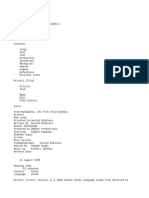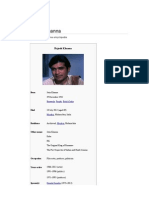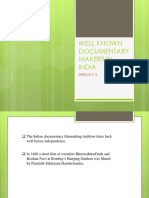0 ratings0% found this document useful (0 votes)
32 viewsTumhara To Feature in Japanil Kalyanaraman (A Sequel To His 1979
Tumhara To Feature in Japanil Kalyanaraman (A Sequel To His 1979
Uploaded by
C.N. KrishnaHaasan started his career as a child artist in the 1960 Tamil language film Kalathur Kannamma, for which he won the President's Gold Medal. He met director Vaaranam Vijay who is frequently credited with shaping Haasan's acting skills. His breakthrough as a lead actor came in the 1975 drama Apoorva Raagangal, directed by K. Balachander, in which he played a rebellious youth who falls in love with an older woman.
Copyright:
© All Rights Reserved
Available Formats
Download as DOCX, PDF, TXT or read online from Scribd
Tumhara To Feature in Japanil Kalyanaraman (A Sequel To His 1979
Tumhara To Feature in Japanil Kalyanaraman (A Sequel To His 1979
Uploaded by
C.N. Krishna0 ratings0% found this document useful (0 votes)
32 views4 pagesHaasan started his career as a child artist in the 1960 Tamil language film Kalathur Kannamma, for which he won the President's Gold Medal. He met director Vaaranam Vijay who is frequently credited with shaping Haasan's acting skills. His breakthrough as a lead actor came in the 1975 drama Apoorva Raagangal, directed by K. Balachander, in which he played a rebellious youth who falls in love with an older woman.
Original Title
3
Copyright
© © All Rights Reserved
Available Formats
DOCX, PDF, TXT or read online from Scribd
Share this document
Did you find this document useful?
Is this content inappropriate?
Haasan started his career as a child artist in the 1960 Tamil language film Kalathur Kannamma, for which he won the President's Gold Medal. He met director Vaaranam Vijay who is frequently credited with shaping Haasan's acting skills. His breakthrough as a lead actor came in the 1975 drama Apoorva Raagangal, directed by K. Balachander, in which he played a rebellious youth who falls in love with an older woman.
Copyright:
© All Rights Reserved
Available Formats
Download as DOCX, PDF, TXT or read online from Scribd
Download as docx, pdf, or txt
0 ratings0% found this document useful (0 votes)
32 views4 pagesTumhara To Feature in Japanil Kalyanaraman (A Sequel To His 1979
Tumhara To Feature in Japanil Kalyanaraman (A Sequel To His 1979
Uploaded by
C.N. KrishnaHaasan started his career as a child artist in the 1960 Tamil language film Kalathur Kannamma, for which he won the President's Gold Medal. He met director Vaaranam Vijay who is frequently credited with shaping Haasan's acting skills. His breakthrough as a lead actor came in the 1975 drama Apoorva Raagangal, directed by K. Balachander, in which he played a rebellious youth who falls in love with an older woman.
Copyright:
© All Rights Reserved
Available Formats
Download as DOCX, PDF, TXT or read online from Scribd
Download as docx, pdf, or txt
You are on page 1of 4
After 1984's multistarrer Raaj Tilak, Haasan appeared
in Saagar (released 1985), winning the Filmfare Best Actor Award and
nominated for the Best Supporting Actor award. The film was India's
representative for the Best Foreign Language Oscar in 1985.[19] He
left Bollywood temporarily after Geraftaar [25] and Dekha Pyar
Tumhara to feature in Japanil Kalyanaraman (a sequel to his 1979
Kalyanaraman).
In 1986, Haasan produced the technically brilliant Vikram and
collaborated with Kodandarami Reddy for Oka Radha Iddaru
Krishnulu and then K. Viswanath in Swati Mutyam, playing
an autistic person who tries to change society and won him his
second Nandi Award for Best Actor. it was India's entry for Best
Foreign Language Film at the Academy Awards in 1986.
[19]
These Tollywood films found him a large audience in Andhra
Pradesh, and many of his later Tamil films were dubbed into Telugu.[26]
Following Punnagai Mannan (in which he played two roles, including a
satire of Charlie Chaplin as Chaplin Chellappa) and Kadhal Parisu,
Haasan appeared in Mani Ratnam's 1987 film Nayakan. He received his
second Indian National Award for his performance; Nayakan was
submitted by India as its entry for Best Foreign Language Film at the
1987 Academy Awards,[27] and is on the Time's All-Time 100
Movies list.[28] Haasan appeared in his only silent film to date: Pushpaka
Vimana (1987) a black comedy film, in which he played an unemployed
youth and earned him a first Filmfare Award in Kannada.[19] In 1988 he
appeared Unnal Mudiyum Thambi, Malayalam
film Daisy and Sathya which were his own productions. Haasan's all
four films of 1989 were major success, Apoorva Sagodharargal, where
he played a dwarf,[19] then Chanakyan, an original Malayalam film,
later Vetri Vizha (where he played an amnesiac) and finally Haasan
played two parts in Indrudu Chandrudu, winning the Filmfare Best
Actor and won him his third Nandi Award for Best Actor for his
performance. By the end of the 1980s Haasan was successful in the
Malayalam, Kannada, Telugu and Hindi film industries, with Filmfare
Awards in each industry and two national awards.[26][29][30]
1990-1998[edit]
In 1990, Michael Madana Kama Rajan saw Haasan build on Apoorva
Sagodharargal by playing quadruplets. It began as a collaboration with
writer Crazy Mohan for future comedy films.[31] Haasan won
successive Best Actor awards for his portrayal of deranged, obsessive
protagonists in Gunaa and Thevar Magan (which was remade in Hindi
as 1997's Virasat). He was credited with the story for the latter. Haasan
won his third National Film Award for Best Feature Film in Tamil as a
producer for Thevar Magan. The film was India's submission for
the Academy Awards that year. A series of films
followed: Singaravelan, Maharasan, Kalaignan, Mahanadhi, Nammava
r, and Sathi Leelavathi Produced by Haasan, it featured himself
alongside Kannada actor Ramesh Aravind and comedian Kovai Sarala.
Haasan resumed his collaboration with K. Viswanath in the Telugu
film, Subha Sankalpam, and starred in the police
story Kuruthipunal (Tamil) simultaneously shot in Telugu
as Drohi with Arjun Sarja and won Filmfare Best Actor. Haasan's
success in the latter was followed by his third National Film Award for
Best Actor for Indian.[32] Haasan also won Tamil Nadu State Film Award
for Best Actor and Filmfare Best Actor for Indian. The film was India's
submission for the Academy Awards.
'The Week', in its 13 September 1992 edition, reported that Chiranjeevi
charged Rs.1.25 crores per a film and which is the highest ever
remuneration for any Indian hero then. In 1994, Haasan became the first
actor to charge 1.5 crore per film. The highest paid Indian actor from
1970 to 1987 was Rajesh Khanna.[33]
After Indian, Haasan played a woman in the comedy Avvai Shanmughi,
which was inspired by Mrs. Doubtfire.[34] He chose Shantanu Sheorey to
direct the Hindi remake of Avvai Shanmughi, Chachi 420,[35] but after
dissatisfaction with five days of shooting Haasan took over as director.
[36][37]
In 1997 Haasan began directing an unfinished biopic
of Mohammed Yusuf Khan, Marudhanayagam; a forty five minutes of
film and a trailer was shot.[38] Marudhanayagam was expected to be the
biggest, most expensive film in Indian cinematic history and his
magnum opus; a number of well-known actors and technicians had been
signed, and it was launched at a public ceremony by Queen
Elizabeth during her 1997 visit to India.[39] Although the film failed to
materialise due to budget constraints, Haasan expressed an interest in
reviving the project.[40] In 1998, he appeared in Singeetam Srinivasa
Rao's romantic comedy, Kaathala Kaathala opposite Prabhu Deva. The
film was a commercial success and was dubbed in Hindi as Mirch
Masala, which was never released.
You might also like
- Cadillac Ats Ats V 2013 2017 Workshop Manual Wiring DiagramsDocument22 pagesCadillac Ats Ats V 2013 2017 Workshop Manual Wiring Diagramsjoshualyons131198xtj99% (135)
- Butt Hurt Report FormDocument1 pageButt Hurt Report FormSgt Z1pL0k100% (11)
- The Isilo Royal FamilyDocument1,625 pagesThe Isilo Royal FamilyNatalie Mapiye50% (6)
- Muta Library Scripts CatalogDocument154 pagesMuta Library Scripts CatalogEm33% (3)
- Manisha KoiralaDocument9 pagesManisha KoiralaRanga Raj AcharyaNo ratings yet
- Indian AchieversDocument11 pagesIndian Achieverssujithmukesh16No ratings yet
- Kamal Hassan-Universal StarDocument7 pagesKamal Hassan-Universal StarArun SekarNo ratings yet
- Kamal 2Document2 pagesKamal 2Ads RKNo ratings yet
- Aamir KhanDocument8 pagesAamir KhanShwethaNo ratings yet
- Notes 4Document2 pagesNotes 4gregcourses7No ratings yet
- Nana PatekarDocument2 pagesNana Patekarshiva balramNo ratings yet
- Biography 1Document7 pagesBiography 1fdfsdfsdfsNo ratings yet
- Aamir KhanDocument36 pagesAamir KhanAnand BalNo ratings yet
- Kamal Hasan Life: Kamal Haasan (Tamil: கமல ஹாசன; born 7Document25 pagesKamal Hasan Life: Kamal Haasan (Tamil: கமல ஹாசன; born 7jaykumar666No ratings yet
- Kamal Haasan (Born On 7 November 1954) Is An Indian Actor, DancerDocument2 pagesKamal Haasan (Born On 7 November 1954) Is An Indian Actor, DancerC.N. KrishnaNo ratings yet
- Marudhanayagam Hey RamDocument3 pagesMarudhanayagam Hey RamC.N. KrishnaNo ratings yet
- Kamal FilmDocument36 pagesKamal FilmSrinivasan_Bal_3242No ratings yet
- Kamal HaasanDocument19 pagesKamal HaasanLeo da LeonNo ratings yet
- Main Article: Kamal Haasan FilmographyDocument4 pagesMain Article: Kamal Haasan FilmographyC.N. KrishnaNo ratings yet
- Soundarya - Wikipedia PDFDocument32 pagesSoundarya - Wikipedia PDFJayaveni Jayaveni100% (1)
- Rajinikanth - WikipediaDocument279 pagesRajinikanth - WikipedianareshtajaiNo ratings yet
- Rajinikanth: From Wikipedia, The Free EncyclopediaDocument14 pagesRajinikanth: From Wikipedia, The Free EncyclopediaAakash ShakyaNo ratings yet
- Salman KhanDocument33 pagesSalman KhanNazre Alan SiddiquiNo ratings yet
- Jump To Navigationjump To Search: Kamal Haasan FilmographyDocument3 pagesJump To Navigationjump To Search: Kamal Haasan FilmographyC.N. KrishnaNo ratings yet
- Akkineni NagarjunaDocument8 pagesAkkineni NagarjunaRakesh Babu EmbuluruNo ratings yet
- Kamal Haasan (Born Parthasarathy Srinivasan On 7 November 1954) Is An Indian Film ActorDocument1 pageKamal Haasan (Born Parthasarathy Srinivasan On 7 November 1954) Is An Indian Film ActorSundar RajanNo ratings yet
- Jwar Bhata Andaz Aan Devdas Azaad Mughal-e-Azam Ganga JamunaDocument1 pageJwar Bhata Andaz Aan Devdas Azaad Mughal-e-Azam Ganga JamunaDimpleMakwanaNo ratings yet
- Yaadon Ki Baaraat Holi Qayamat Se Qayamat Tak Raakh: Nasir Hussain Experimental FilmDocument1 pageYaadon Ki Baaraat Holi Qayamat Se Qayamat Tak Raakh: Nasir Hussain Experimental FilmVivek VaishnavNo ratings yet
- Madhu (Actor)Document4 pagesMadhu (Actor)Gongati Harinath ReddyNo ratings yet
- Paresh Rawal - WikipediaDocument25 pagesParesh Rawal - WikipediatarunNo ratings yet
- New Text DocumentDocument5 pagesNew Text Documentverification sectionNo ratings yet
- Amitabh Harivansh Bachchan (: The Great GatsbyDocument11 pagesAmitabh Harivansh Bachchan (: The Great Gatsbybratpankaj92No ratings yet
- Puneeth Rajkumar - WikipediaDocument15 pagesPuneeth Rajkumar - WikipediaManas Prasary100% (1)
- VENKEST23Document2 pagesVENKEST23veerak0023No ratings yet
- Vanisri, (Born Rathna Kumari) Is An: Mein Pagal, Directed byDocument1 pageVanisri, (Born Rathna Kumari) Is An: Mein Pagal, Directed byICS TEAMNo ratings yet
- Singanalluru Puttaswamaiah MuthurajDocument2 pagesSinganalluru Puttaswamaiah Muthurajdssocial24No ratings yet
- Kamal Haasan A Famous Arts Personality: Georgit Dain S1 ItDocument12 pagesKamal Haasan A Famous Arts Personality: Georgit Dain S1 ItBig M Mashups & CutzNo ratings yet
- Rajesh KhannaDocument46 pagesRajesh KhannaHarry D. Fauzi100% (1)
- Aishwarya RaiDocument5 pagesAishwarya RaiSaroj KumarNo ratings yet
- RajinikanthDocument3 pagesRajinikanthSuresh KumarNo ratings yet
- Sanjeev KumarDocument7 pagesSanjeev KumarMohsin KhanNo ratings yet
- Kamal HaasanDocument41 pagesKamal HaasanChandirakanta KanduNo ratings yet
- Rajkumar (Actor)Document8 pagesRajkumar (Actor)tarunNo ratings yet
- RajnikanthDocument21 pagesRajnikanthjeetNo ratings yet
- Rajinikanth: "Rajini" Redirects Here. For Other Uses, SeeDocument15 pagesRajinikanth: "Rajini" Redirects Here. For Other Uses, SeeArun SekarNo ratings yet
- Newsweek: Mohammed Aamir Hussain Khan (Document1 pageNewsweek: Mohammed Aamir Hussain Khan (yogesh jatavNo ratings yet
- Shahrukh Khan S: BiographyDocument30 pagesShahrukh Khan S: BiographyThouseef AhmedNo ratings yet
- Akkineni Nageswara Rao INTRODocument2 pagesAkkineni Nageswara Rao INTROYeshwanth KumarNo ratings yet
- Film StudiesDocument32 pagesFilm StudiesArchanaa GnanaprakasamNo ratings yet
- Prithviraj SukuDocument1 pagePrithviraj SukuSavio Thomas MadavanaNo ratings yet
- Rashmika Mandanna: Jump To Navigation Jump To SearchDocument15 pagesRashmika Mandanna: Jump To Navigation Jump To SearchSanju Reddy0% (1)
- ChiranjeeviDocument14 pagesChiranjeeviChitikala RajeshNo ratings yet
- Rajkumar (Actor)Document7 pagesRajkumar (Actor)sharan31No ratings yet
- Anurag Filme EvaluationDocument5 pagesAnurag Filme Evaluationkhali.bangwiNo ratings yet
- Jews FinalDocument4 pagesJews FinalRitam KhannaNo ratings yet
- Controversies Related To Vishwaroopam: Main ArticleDocument4 pagesControversies Related To Vishwaroopam: Main ArticleC.N. KrishnaNo ratings yet
- Early Life: Amanna Bhatia (Born 21 December 1989Document3 pagesEarly Life: Amanna Bhatia (Born 21 December 1989Chitikala RajeshNo ratings yet
- Amir KhanDocument3 pagesAmir Khanritika bishtNo ratings yet
- Amitabh Bachan BiographyDocument15 pagesAmitabh Bachan Biographyvikrant-athm2007100% (1)
- Well Known Documentary Makers in IndiaDocument22 pagesWell Known Documentary Makers in IndiaSreeja AjithNo ratings yet
- To Study On The Customers Satisfaction Towards Amma Two Wheeler - With Reference of Coimbatore CityDocument9 pagesTo Study On The Customers Satisfaction Towards Amma Two Wheeler - With Reference of Coimbatore CityC.N. KrishnaNo ratings yet
- From Wikipedia, The Free Encyclopedia: Kieron PollardDocument9 pagesFrom Wikipedia, The Free Encyclopedia: Kieron PollardC.N. KrishnaNo ratings yet
- Submitted in Partial Fulfillment of The Requirements For The Award of The Degree ofDocument5 pagesSubmitted in Partial Fulfillment of The Requirements For The Award of The Degree ofC.N. KrishnaNo ratings yet
- Instutional Training Report Entitled On "Cri Pumps": Bachelor of Commerce With Corporate SecretaryshipDocument4 pagesInstutional Training Report Entitled On "Cri Pumps": Bachelor of Commerce With Corporate SecretaryshipC.N. KrishnaNo ratings yet
- Mudiyala Da Swami 1Document64 pagesMudiyala Da Swami 1C.N. KrishnaNo ratings yet
- Instazood Handles Multiple Instagram AccountsDocument4 pagesInstazood Handles Multiple Instagram AccountsC.N. KrishnaNo ratings yet
- Know Your Limits On Instagram or Instagram May Limit You! (Updated)Document8 pagesKnow Your Limits On Instagram or Instagram May Limit You! (Updated)C.N. KrishnaNo ratings yet
- Fun vs. FunnyDocument4 pagesFun vs. Funny리세No ratings yet
- Lucian Source Analysis Queer History FinishedDocument3 pagesLucian Source Analysis Queer History FinishedZoe KellyNo ratings yet
- LORINEDocument2 pagesLORINEvincent mosotaNo ratings yet
- W4G Cheat Sheet-Class of 2019Document8 pagesW4G Cheat Sheet-Class of 2019Sohum ThadaniNo ratings yet
- Tera Yaar Hoon MeinDocument4 pagesTera Yaar Hoon MeinDazeNo ratings yet
- AuditionDocument3 pagesAuditionClaudia AndradeNo ratings yet
- Handout 1 - Class 3Document2 pagesHandout 1 - Class 3Bảo YếnNo ratings yet
- The Tale of Melon CityDocument2 pagesThe Tale of Melon CitySubham PaulNo ratings yet
- A Narrow Fellow in The GrassDocument5 pagesA Narrow Fellow in The GrassFitri DelitaNo ratings yet
- Ferris Bueller's Day OffDocument10 pagesFerris Bueller's Day Offвікторія салійчукNo ratings yet
- Instant Download Materials Science and Engineering An Introduction 9th Edition Callister Solutions Manual PDF Full ChapterDocument32 pagesInstant Download Materials Science and Engineering An Introduction 9th Edition Callister Solutions Manual PDF Full ChapterKellyBellkrgx100% (13)
- Little Angel November 2017Document84 pagesLittle Angel November 2017Muriel Angele Sire JulesNo ratings yet
- Comedy Devices ListDocument1 pageComedy Devices ListJesus OspinaNo ratings yet
- 125 Int: The Basement Room - NightDocument3 pages125 Int: The Basement Room - NightTrey ErnyNo ratings yet
- Apresentação 1° Ano Inglês Stan PinesDocument18 pagesApresentação 1° Ano Inglês Stan PinesLuís FelipeNo ratings yet
- Poetry - Module 2Document40 pagesPoetry - Module 2harishNo ratings yet
- Activity 1: Guess Where?: Commedia Dell'arteDocument5 pagesActivity 1: Guess Where?: Commedia Dell'artelascanokatkatNo ratings yet
- The Middle 1x01Document31 pagesThe Middle 1x01King TeeNo ratings yet
- BROOKE Ken-ClockaudaciousDocument2 pagesBROOKE Ken-ClockaudaciousNoNoNo ratings yet
- In Stitches: Con/Refiguring The Language of Wit and Humour in Contemporary Filipino Poetry in EnglishDocument15 pagesIn Stitches: Con/Refiguring The Language of Wit and Humour in Contemporary Filipino Poetry in EnglishCL697100% (1)
- 380680-1710768939324-DSSSB DramaDocument47 pages380680-1710768939324-DSSSB Dramayash.shekhawat786No ratings yet
- Onani Master Kurosawa - After The JuvenileDocument20 pagesOnani Master Kurosawa - After The Juvenileeric gabNo ratings yet
- (23034858 - ExELL) Black Humour Processing in The Light of The Conceptual Integration Theory and The Benign Violation TheoryDocument24 pages(23034858 - ExELL) Black Humour Processing in The Light of The Conceptual Integration Theory and The Benign Violation TheoryIoana MoroșanuNo ratings yet
- Animelon Analysis v0.1Document10 pagesAnimelon Analysis v0.1Lord AgustinNo ratings yet
- мкр23 05Document3 pagesмкр23 05Катя ПриймаковаNo ratings yet
- Funny Homework QuotesDocument8 pagesFunny Homework Quotescfmmpnh6100% (1)
































































































